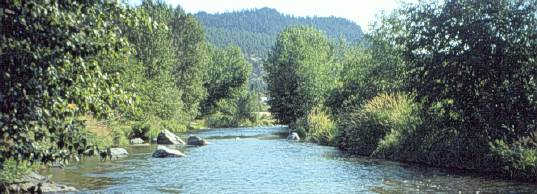Aquatic Invertebrates of Montana
Tubifex Summary by Stream

- Missouri River mainstem. Four samples (154, 155, 190 and 192) between Holter Dam and Ulm Bridge indicate
that Tubifex is abundant and dominant (over 50%) in the upper part of this reach,
but it drops to non-detectable levels by Ulm Bridge- about the same as the trout.
More work is needed to document the density pattern along the river, but Tubifex is
common where the trout are common. While there is abundant life in the river, these
consist of very few species and mostly non-insects. The modified flow and temperature
below the dams are likely the cause for this. The entire blue ribbon section of the
Missouri River can likely support the parasite. The disease might be light near the
dam where spore loading may be limited.
- Dearborn River:. Two samples (188, 209) from the 287 bridge cover the spring and fall seasons. These
took only a few worms, but most of them are Tubifex. Other species were also represented
by only sparse populations. There is no mud and only limited sand present at this
site. The worms live can live in the larger substrates due to lack of other species.
Water and land use in the drainage probably cause the problem here. There are probably
many areas with high Tubifex populations elsewhere in the drainage. All areas of the
drainage available to spawning fish from the Missouri are probably able to support
the parasite.
- Sheep Creek: One large sample (202) from early September took only a small number of worms with
no sign of Tubifex. The site has many species present. Even the late summer sample
had 38 species with 23 EPT (Ephemeroptera- mayflies, Plecoptera- stoneflies and Trichoptera-
caddisflies). Tubifex seems unlikely in this stream, which should therefore continue
to provide disease-free early rearing for trout. Young of the year rainbows were very
abundant in early September. These will probably return to the river by winter- hopefully
after the TAM season.
- Wolf Creek: One large sample (201) from early September took many worms, but no Tubifex. The
community here is rich in species, similar to Sheep Creek. So like Sheep Creek, Tubifex
seems unlikely and the stream should continue to provide disease-free early rearing
for trout. Young of the year rainbows were very abundant in early September. These
will probably return to the river by winter- hopefully after the TAM season. On November
10, 1996 a second large sample (262) was taken further upstream. This site showed
some signs of excessive sedimentation and some spring seepage, but as expected, it
had no trace of Tubifex. With additional disturbance Tubifex might appear here, but
it should be fairly easily reversed with increased protection to the stream.
- Lyons Creek: One large sample (201) from early September took many worms, but only a single worm
could be Tubifex. It was too immature to be sure. Like Sheep Creek and Wolf Creek,
the community here is a rich one and it seems unlikely Tubifex will be present. The
sample site was very low on the stream (between the freeway and the mouth), which
may explain a single possible Tubifex. This stream should also provide disease-free
early rearing for trout. Young of the year rainbows were very abundant in early September.
These will probably return to the river by winter- hopefully after the TAM season.
On November 10, 1996 a second large sample (260) was taken further upstream. This
sample, as expected, had no trace of Tubifex.
- Canyon Creek: One large sample (189) from early September took very few worms, but about a third
of these might be Tubifex. They were too immature to be sure. The community here is
a rich one and it is likely that Tubifex is limited to the lower parts of the creek
and to backwater areas. This area of the stream has some agricultural impacts. Few
or no river fish spawn this far upstream.
- Little Prickly Pear Creek: Eleven samples (199, 169, 191, 204, 206 182, 216, 185, 183, 205 and 186) along this creek indicate an interesting situation. The headwater of the stream have abundant worms, but no Tubifex. Toward the confluence with Canyon Creek the total worm density declines, but Tubifex enters the community. Moving downstream below the upper agricultural area Tubifex becomes abundant. All of that is perfectly normal, but now it gets more interesting. Below the Seiben Flats area the creek was straightened and narrowed to accommodate the freeway, railroad and up to 2 frontage roads through a narrow canyon. Here the native community recovers and there is little room for Tubifex. Tubifex is present, but it is neither abundant nor dominant in the worm community. In this area of the stream the Tubifex are not mature by late-summer, while in the middle parts of the drainage, many are already mature by that time. This may indicate marginal habitat for them in some way, or it could be that the worms in the canyon are mostly lost with the spring runoff and they need more time to reestablish and grow. In the lowest part of the drainage, the stream again enters agricultural land and Tubifex increases again, but they are still not mature by late-summer. This might be evidence for a major loss of worms with high water. So while the middle part of the drainage seems well suited for the parasite, the main spawning areas of the canyon might be worm limited or even spore limited, at least in some years. We must wait and see what develops, but see also by recommendations.
16 OCT 1996, updated on 22 DEC 1996 D.L. Gustafson
Back to the Little Prickly Pear Creek
